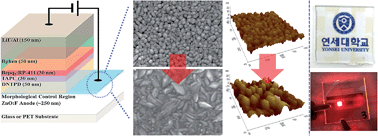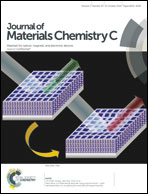Enhanced hole injection into indium-free organic red light-emitting diodes by fluorine-doping-induced texturing of a zinc oxide surface†
Abstract
We investigated the effect of fluorine (F)-doping-induced texturing of a zinc oxide (ZnO) surface to enhance the hole injection properties of an organic light emitting diode (OLED) device. In this work, 250 nm thick ZnO anodes doped with 0, 0.2, 0.5, and 0.7 at.% F were grown on liquid crystal display (LCD) glass substrates by atomic layer deposition (ALD) at a low temperature (140 °C). The sheet resistance of undoped ZnO and F-doped ZnO (ZnO:F) anodes decreased with increased F-doping in the ZnO matrix. Conversely, the work functions of the doped ZnO anodes gradually increased with the increase in surface texturing caused by an increase in the amount of exposed (100) planes. Finally, the best OLED performance was obtained for a ZnO anode containing 0.5 at.% F; the work function value of this film was 4.74 eV. The highest luminance and current density values (at a bias of 20 V) were optimized to be 13 509.55 cd m−2 and 247.98 mA cm−2, respectively. These superior properties were obtained in an OLED device composed of a DNTPD/TAPC/Bebq2:10%-doped RP-411/Bphen/LiF/Al structure on a ZnO:F anode containing 0.5 at.% F.


 Please wait while we load your content...
Please wait while we load your content...